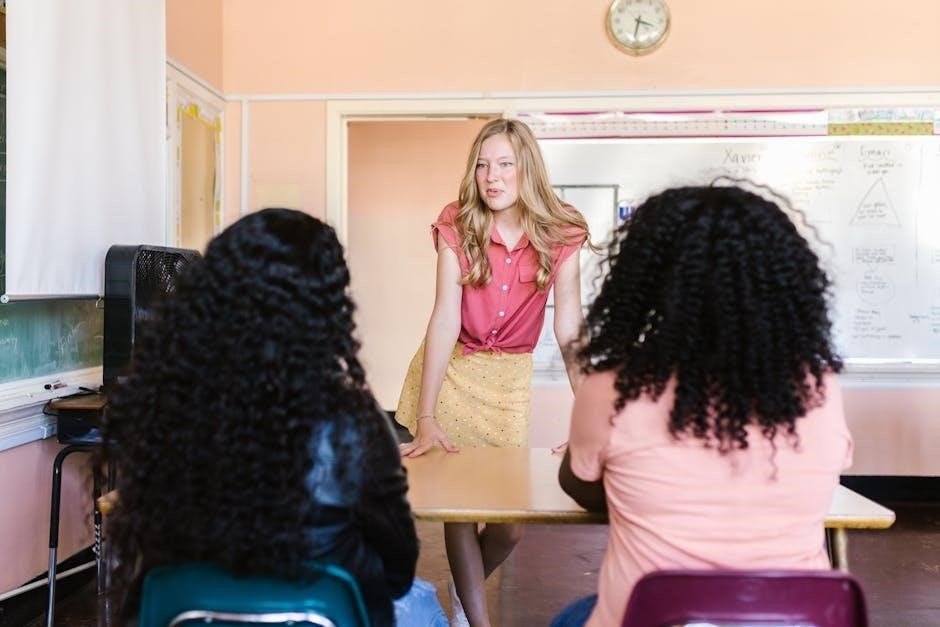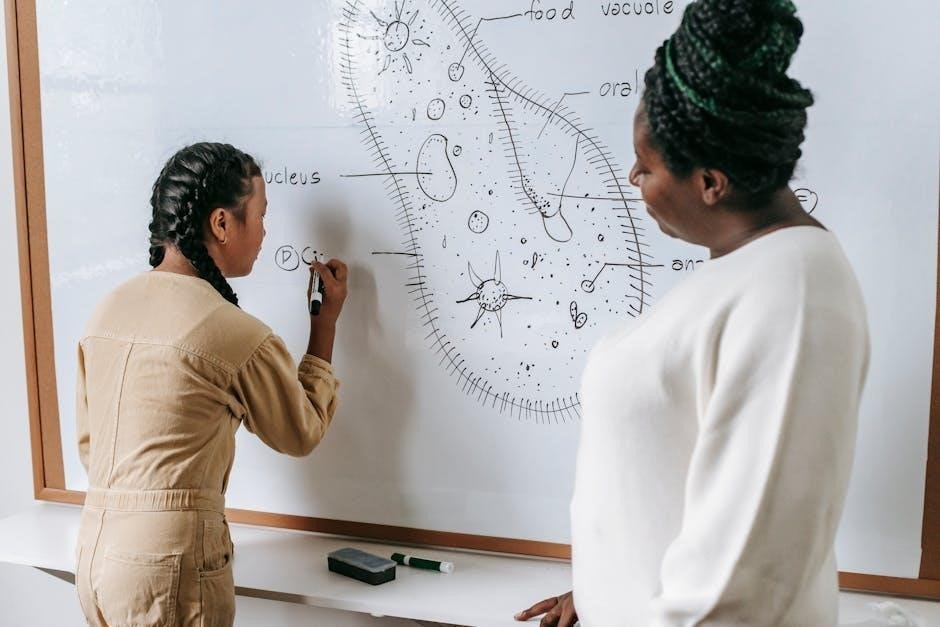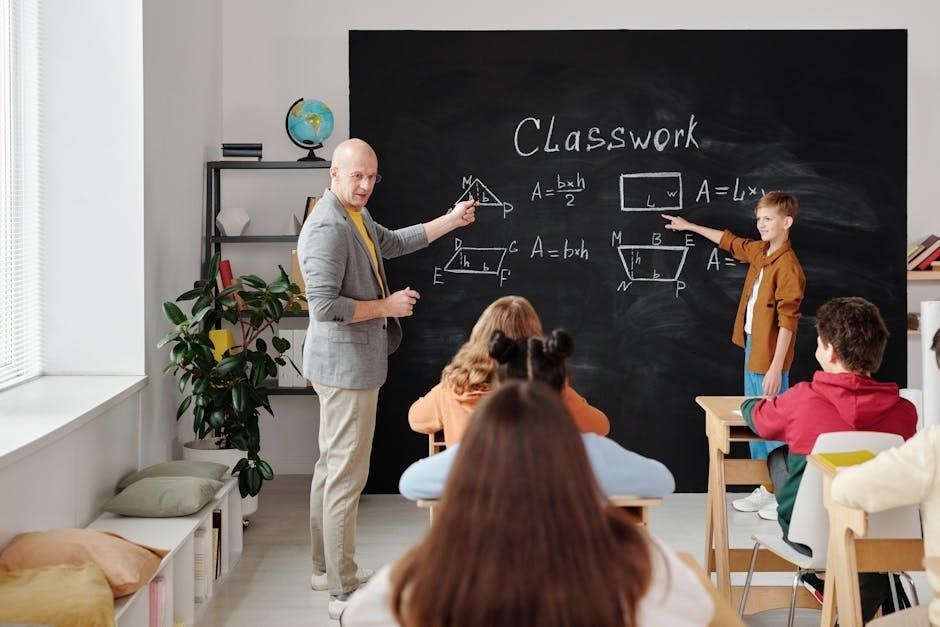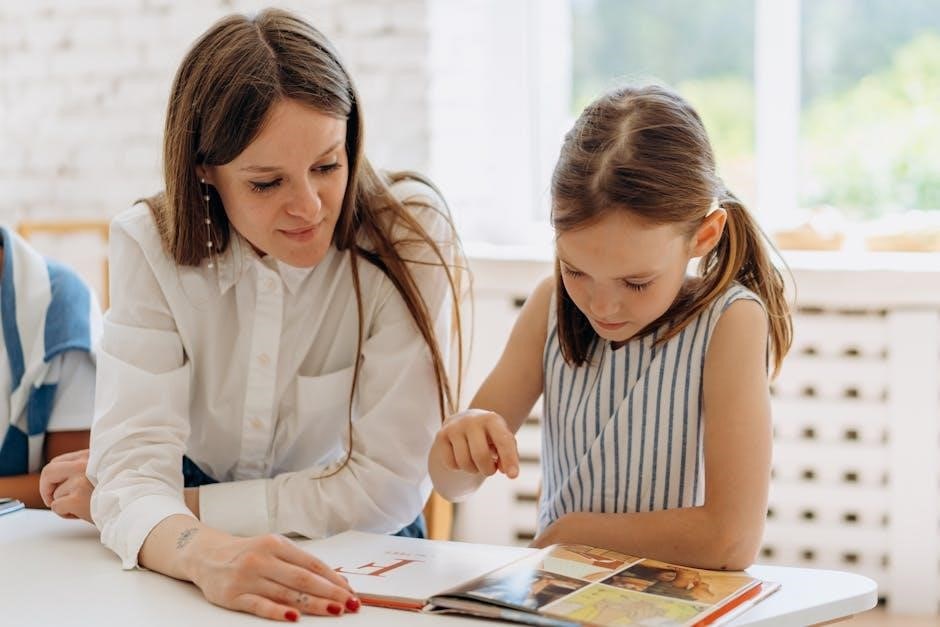The first instruction is crucial as it sets the tone and expectations, creating a positive environment and ensuring psychological safety and engagement, vital for learning.
1.1 Importance of the First Instruction
The first instruction is foundational, as it shapes the classroom environment and sets the tone for the entire academic year. It establishes expectations, builds rapport, and creates psychological safety, ensuring students feel comfortable and engaged. A well-crafted first instruction fosters motivation, encourages participation, and lays the groundwork for effective learning. It also addresses diverse needs and promotes inclusivity, ensuring all students feel valued. By prioritizing clarity and empathy, the first instruction builds confidence and sets students on a path to success. Its impact extends beyond the initial lesson, influencing long-term classroom dynamics and student outcomes, making it a critical component of effective teaching strategies. Proper execution ensures a positive and productive start to the educational journey.
1.2 Setting the Tone for the Year

The first instruction significantly influences the classroom atmosphere, shaping students’ attitudes and expectations for the entire academic year. A well-delivered initial lesson establishes a culture of respect, engagement, and inclusivity, fostering a positive environment where students feel valued and motivated. It also communicates the teacher’s approach to learning, emphasizing collaboration, creativity, and critical thinking. By setting clear expectations and encouraging active participation, the first instruction lays the groundwork for a productive and supportive classroom dynamic. This foundational experience not only enhances student confidence but also creates a sense of belonging, which is essential for long-term academic success and personal growth. The tone set in the first instruction profoundly impacts how students perceive learning and their role within it.

Establishing Classroom Expectations
Clear expectations for behavior and academic conduct are essential, fostering a structured and respectful environment that promotes engagement and accountability, ensuring a productive learning environment for all students.
2.1 Setting Clear Rules and Norms
Setting clear rules and norms is essential for establishing a structured and respectful classroom environment. These guidelines help students understand what is expected of them, fostering accountability and focus. Clear rules ensure consistency and fairness, while norms promote a culture of respect and collaboration. Teachers should communicate these expectations early, ideally during the first instruction, to avoid confusion and set the tone for the year. Examples include rules for participation, respect, and punctuality, as well as norms for group work and communication. By clearly outlining these expectations, teachers create a predictable and supportive environment, allowing students to concentrate on learning and reducing potential disruptions.
2.2 Encouraging Student Participation
Encouraging student participation is vital for fostering engagement and active learning. Teachers should create an environment where all students feel comfortable contributing their thoughts and ideas. This can be achieved by using strategies such as think-pair-share, small group discussions, and open-ended questions. Recognizing and valuing diverse perspectives encourages students to participate more freely. Additionally, incorporating movement and hands-on activities can increase involvement, especially for kinesthetic learners. Positive reinforcement, such as verbal praise, can also motivate students to take part. By encouraging participation, teachers promote critical thinking, collaboration, and a sense of ownership among students, which are essential for academic success and personal growth.

Building Teacher-Student Relationships
Building strong teacher-student relationships is the cornerstone of a successful learning environment. It fosters mutual respect, empathy, and trust, creating a supportive atmosphere for growth and collaboration.
3.1 Creating a Positive Classroom Environment
Creating a positive classroom environment is essential for fostering engagement and learning. A welcoming atmosphere encourages students to feel safe, valued, and motivated; Teachers should promote respect, inclusivity, and open communication from the first day. Organizing the classroom layout to facilitate collaboration and movement can enhance interaction. Displaying inspiring visuals and student work can also create a sense of ownership and pride. Establishing a growth mindset culture and encouraging positive language helps build confidence. A well-structured, organized, and visually appealing space sets the foundation for a productive and supportive learning community, ensuring students feel comfortable to participate and grow academically and socially;
3.2 Building Rapport with Students
Building rapport with students is crucial for establishing trust and fostering a supportive learning environment. Teachers should take the time to learn about their students’ interests, backgrounds, and goals. Showing genuine care and enthusiasm helps students feel valued and connected. Active listening, positive body language, and approachable demeanor are key. Sharing personal anecdotes or experiences can create a sense of relatability. Encouraging one-on-one interactions and being accessible for questions or concerns strengthens the bond. Consistently demonstrating empathy and understanding helps students feel secure and confident in their teacher’s guidance. A strong teacher-student relationship is foundational for academic success and personal growth, making it essential to prioritize rapport-building from the first instruction.

First Day Activities
The first day sets the tone, introducing students to classroom routines, expectations, and the teacher’s personality. Activities focus on building connections and establishing a positive, engaging environment.
4.1 Icebreaker Activities
Icebreaker activities are essential for creating a welcoming atmosphere on the first day. They help students feel comfortable, reduce initial anxiety, and encourage interaction. Teachers often use group discussions, quick games, or interactive exercises to foster connections. These activities not only help students get to know each other but also allow the teacher to learn about their personalities and interests. Examples include “Two Truths and a Lie,” “Human Bingo,” or sharing fun facts. By engaging in these exercises, students begin to build rapport with peers and feel more at ease in the classroom environment. This sets a positive foundation for collaboration and participation throughout the year.
4.2 Reviewing the Syllabus
Reviewing the syllabus is a crucial step in the first instruction, as it outlines the course structure, expectations, and objectives. Teachers guide students through the document, highlighting key sections such as grading criteria, assignment deadlines, and classroom policies. This process ensures clarity and sets a transparent tone for the year. By discussing the syllabus, teachers also address any questions or concerns, fostering a sense of preparedness. It’s an opportunity to emphasize important routines, such as homework submission, late policies, and participation expectations; This step helps students understand the workload and aligns their goals with the course outcomes, creating a shared understanding of what lies ahead. It builds trust and establishes a clear roadmap for success.

Assessing Student Needs
Assessing student needs is vital for understanding their academic and personal requirements. Teachers use initial evaluations to identify strengths, weaknesses, and learning gaps, guiding instruction effectively.
5.1 Initial Assessments and Baseline Testing
Initial assessments and baseline testing are crucial for understanding students’ starting points. These tools help teachers identify academic strengths, weaknesses, and knowledge gaps. By administering diagnostic tests, surveys, or informal observations, educators gather insights into students’ skills and readiness. This data informs instruction, allowing teachers to tailor lessons to meet diverse needs. Baseline testing also establishes a reference point for measuring progress throughout the year. It ensures that instruction builds on what students already know, fostering a more personalized and effective learning experience. Accurate assessments enable teachers to address individual differences and set realistic goals, laying a strong foundation for student success. This step is essential for aligning teaching strategies with student needs.
5.2 Identifying Learning Styles
Identifying learning styles is vital for tailoring instruction to meet individual student needs. Teachers use various methods to determine whether students are visual, auditory, or kinesthetic learners. This understanding allows for differentiated instruction, enhancing engagement and comprehension. By incorporating diverse teaching strategies, educators can cater to all learning preferences, ensuring no student is left behind. Recognizing learning styles early on helps create a personalized learning environment, fostering academic success and student confidence. This approach promotes inclusivity and addresses the unique ways students process information. Effective identification of learning styles is key to maximizing learning potential and creating a supportive classroom atmosphere. It ensures that instruction is accessible and meaningful for everyone. This practice lays the groundwork for a successful and engaging educational experience.

The Impact of First Instruction
The first instruction profoundly shapes student engagement, motivation, and expectations. It sets the tone for the learning environment and establishes the teacher’s approach, influencing future interactions and academic success.
6.1 Influence on Student Motivation
The first instruction significantly impacts student motivation by setting the foundation for engagement and curiosity. A well-structured introduction fosters a sense of belonging and excitement, encouraging students to participate actively.
When teachers present the material with enthusiasm and clarity, students are more likely to develop a positive attitude toward learning. This initial interaction can ignite intrinsic motivation, driving students to take ownership of their education and strive for success throughout the year.
6.2 Long-term Classroom Management
The first instruction plays a pivotal role in shaping long-term classroom management by establishing clear expectations and routines from the outset. When teachers introduce structured guidelines and consistent consequences, students quickly adapt to the classroom culture, fostering a disciplined environment. This initial setup reduces potential behavioral challenges and encourages mutual respect, creating a foundation for effective management throughout the year. By clearly communicating expectations, teachers ensure that students understand their roles and responsibilities, promoting a sense of accountability and cooperation. This proactive approach not only enhances academic focus but also cultivates a positive and respectful classroom atmosphere, making long-term management more manageable and sustainable. Consistency in enforcing these expectations further reinforces the established norms, ensuring a well-organized learning space.

Inclusivity in the First Instruction
Inclusivity in the first instruction ensures all students feel valued, respected, and supported, regardless of their background, abilities, or perspectives. Teachers foster a welcoming environment by incorporating diverse materials and encouraging open dialogue, promoting equity and belonging from day one.
7.1 Addressing Diverse Learning Needs
Addressing diverse learning needs is critical in the first instruction to ensure every student can engage effectively. Teachers must recognize and accommodate different learning styles, such as visual, auditory, and kinesthetic learners. Additionally, they should identify students with special needs or disabilities and prepare appropriate accommodations. This might include providing materials in multiple formats or using assistive technologies; By incorporating universal design for learning (UDL) principles, teachers create a flexible learning environment that caters to individual differences. Early assessment of students’ strengths and challenges helps tailor instruction, fostering equity and inclusivity from the start. This proactive approach ensures all students feel supported and empowered to succeed.
7.2 Cultural Sensitivity in Teaching
Cultural sensitivity is essential in the first instruction to create an inclusive and respectful learning environment. Teachers should acknowledge and appreciate the diverse backgrounds, traditions, and perspectives of their students. This involves incorporating culturally responsive teaching practices, such as using diverse examples and materials that reflect students’ experiences. Celebrating different cultures and addressing potential biases fosters a sense of belonging and engagement. By being culturally aware, teachers can break down barriers and ensure all students feel valued. This approach not only enhances learning but also promotes social harmony and mutual understanding. Cultural sensitivity in teaching lays the foundation for a positive and inclusive classroom atmosphere.

Strategies for Effective First Instruction
Effective first instruction involves engaging students with clear goals, interactive activities, and tailored approaches to meet diverse needs and foster a productive learning environment.
8.1 Active Learning Techniques
Active learning techniques are essential for engaging students from the start. These methods encourage participation, critical thinking, and collaboration. Techniques include group discussions, problem-solving activities, hands-on experiments, and think-pair-share exercises. By incorporating these strategies, teachers create dynamic lessons that cater to diverse learning styles. Active learning fosters a deeper understanding of material and promotes long-term retention. It also allows educators to assess student comprehension in real-time, making immediate adjustments. These approaches not only enhance academic performance but also build confidence and enthusiasm among students, setting a positive tone for the rest of the year. They ensure that learning is interactive, meaningful, and tailored to individual needs, making the first instruction impactful and effective.
8.2 Integrating Technology
Integrating technology into the first instruction enhances engagement and prepares students for modern learning. Tools like educational apps, interactive whiteboards, and online platforms create immersive experiences. Teachers can use technology to present content dynamically, such as through videos or simulations, making complex concepts accessible. Additionally, digital collaboration tools foster teamwork and communication among students. Technology also enables personalized learning, allowing teachers to tailor instruction to individual needs. Real-time feedback through quizzes or polls helps gauge student understanding immediately. However, it’s crucial to ensure all students have equal access to these tools. By seamlessly incorporating technology, educators create a forward-thinking classroom environment that motivates students and sets the stage for future success. This approach ensures that learning is both innovative and inclusive from the very beginning.

Psychological Considerations
The first instruction should foster psychological safety, build trust, and create a welcoming environment to enhance students’ engagement, motivation, and confidence in learning.
9.1 First Impressions and Psychological Safety
The first instruction sets the tone for the entire academic journey, making it crucial to create a psychologically safe environment where students feel secure and valued. A teacher’s approach on the first day significantly influences students’ perceptions and engagement; Positive non-verbal cues, such as a warm smile and open body language, can instantly build trust. Clear communication about expectations and routines helps reduce anxiety, fostering a sense of belonging. Psychological safety encourages students to take risks, ask questions, and participate actively without fear of judgment. Research shows that such environments lead to higher academic performance and better student-teacher relationships. Addressing these elements ensures a strong foundation for the year ahead.
9.2 Building Confidence in Students
Building confidence in students during the first instruction is essential for fostering their academic and personal growth. A teacher can achieve this by acknowledging students’ strengths and providing constructive feedback. Encouraging participation, even in small ways, helps students feel valued and capable. Celebrating successes, no matter how minor, reinforces a positive self-image. Creating opportunities for students to take ownership of their learning, such as leading discussions or sharing ideas, further enhances their confidence. Positive reinforcement and a growth mindset approach empower students to view challenges as opportunities to learn rather than obstacles. This supportive environment helps students develop resilience and belief in their abilities, setting a strong foundation for the year ahead.
The first instruction sets the foundation for a successful academic year, influencing both student outcomes and classroom dynamics. By prioritizing clear expectations, fostering relationships, and engaging students, teachers create an environment conducive to learning. Effective first instruction not only motivates students but also establishes a culture of respect and accountability. It addresses diverse needs, integrates technology, and builds confidence, ensuring students feel safe and supported. Ultimately, a well-planned first instruction lays the groundwork for long-term success, enabling students to thrive academically, socially, and emotionally. Teachers who invest in a strong start empower their students to embrace challenges and grow throughout the year, making the first instruction a critical catalyst for achievement.